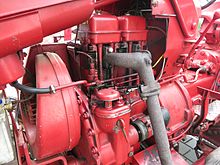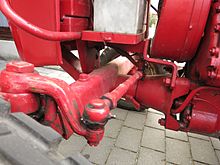Frameless block construction
The frameless block construction , together with the frame construction (for example ladder , lattice and central tube frame ) and the self-supporting body, is a further possibility of connecting the individual vehicle parts in a vehicle to form a supporting structure. This design is common for industrial trucks and farm tractors . All of the vehicle components required for operation are directly connected to one another. In agricultural tractors, for example, the rear axle, gearbox, clutch and the engine block, which are bolted together via flanges, usually form a unit and the front axle is articulated to the engine housing by means of a bolt. For this construction, the engine installed in the middle of a tractor must be provided with a particularly strong crankcase so that the front and rear axle structures can be attached there, because all these components are self-supporting. Alternatively, the oil pan can also be used as a load-bearing component of the engine be trained. With the frameless block construction, body components are not necessary to complete the vehicle, but tractors often have fenders, a hood and a cabin.
Individual evidence
- ^ A b F. Sass, C. Bouche, A. Leitner: Dubbels Taschenbuch für den Maschinenbau . Ed .: F. Sass, C. Bouche, A. Leitner. 12th edition. tape 2 . Springer-Verlag, Berlin, Heidelberg 1963, ISBN 978-3-662-41645-7 , pp. 497 (976 pp.).
- ↑ Andreas Scheiterlein: The structure of the high-speed internal combustion engine . In: Hans List (Ed.): The internal combustion engine . 2nd Edition. tape 11 . Springer-Verlag, Vienna 1964, ISBN 978-3-662-24344-2 , D. Motorkonstruktionen, p. 199 (523 pp.).


